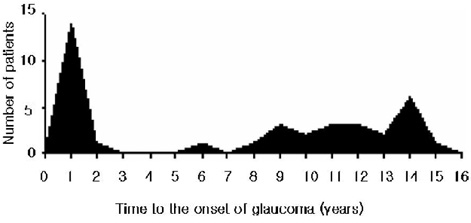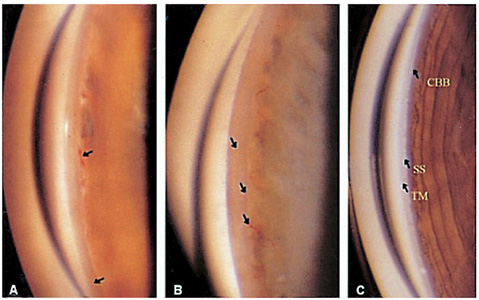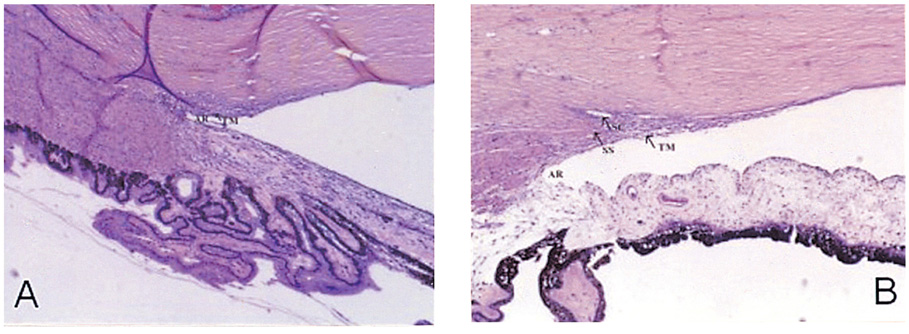Korean J Ophthalmol.
2006 Mar;20(1):41-46. 10.3341/kjo.2006.20.1.41.
Comparison of Delayed-Onset Glaucoma and Early-Onset Glaucoma after Infantile Cataract Surgery
- Affiliations
-
- 1Department of Ophthalmology, St. Mary's Hospital, College of Medicine, The Catholic University of Korea, Seoul, Korea.
- 2Our Lady of Mercy Hospital, College of Medicine, The Catholic University of Korea, Seoul, Korea. yimhb@catholic.ac.kr
- 3Department of Ophthalmology, University of Pittsburgh School of Medicine, Pittsburgh, USA.
- KMID: 1099071
- DOI: http://doi.org/10.3341/kjo.2006.20.1.41
Abstract
- PURPOSE: To investigate the causes and characteristics of glaucoma in children following cataract surgery. METHODS: Twenty-four patients (37 eyes) with uncomplicated congenital cataracts who developed glaucoma after cataract surgery were studied retrospectively. Variables included cataract morphology, surgical techniques, post-operative complications, time to the onset of glaucoma, gonioscopic findings, presence of microcornea and the histopathologic characteristics of the filtration angle (in one case). RESULTS: There was a bimodal onset of glaucoma after cataract surgery. Early-onset glaucoma occurred at a mean age of 6 months in 15 eyes and delayed-onset glaucoma at a mean age of 12 years in 22 eyes. Early-onset glaucoma was significantly (p=0.018) more likely to be due to angle closure than delayed-onset glaucoma. With delayed-onset glaucoma, the filtration angle was open in 86% of eyes and significantly (p=0.006) more eyes in the delayed-onset group had microcornea. Medical treatment was sufficient to control intraocular pressure in the delayed-onset group while the early-onset group required surgical treatment (P<0.001). CONCLUSIONS: The onset of glaucoma after cataract surgery during infancy follows a bimodal pattern that is correlated with the configuration of the filtration angle. The early-onset glaucoma group had high incidence of angle closure requiring surgical treatment, while in the delayed-onset group non-surgical treatment was sufficient to control intraocular pressure. Prophylactic iridectomy in eyes at risk for pupillary block is recommended. Eyes with delayed-onset glaucoma have open filtration angles yet also have findings of incomplete development of filtration structures. Microcornea is a risk factor for delayed-onset glaucoma.
Keyword
MeSH Terms
-
Time Factors
Risk Factors
Retrospective Studies
Postoperative Complications
Male
Intraocular Pressure
Infant
Humans
Gonioscopy
Glaucoma, Open-Angle/diagnosis/*etiology/physiopathology
Glaucoma, Angle-Closure/diagnosis/*etiology/physiopathology
Follow-Up Studies
Female
Child, Preschool
Child
Cataract Extraction/*adverse effects
Cataract/congenital
Age Factors
Adult
Adolescent
Figure
Cited by 1 articles
-
Risk Factors of Secondary Glaucoma after Congenital Cataract Surgery in Korean Patients
Ga-In Lee, Jong Chul Han, Si Bum Kim, Eun Jung Lee, Chang Won Kee
J Korean Ophthalmol Soc. 2018;59(6):569-576. doi: 10.3341/jkos.2018.59.6.569.
Reference
-
1. Chandler PA. Surgery for congenital cataract. Am J Ophthalmol. 1968. 65:663–673.2. Phelps CD, Arafat NI. Open-angle glaucoma following surgery for congenital cataracts. Arch Ophthalmol. 1977. 95:1985–1987.3. Chrousos GA, Parks MM, O'Neill JF. Incidence of chronic glaucoma, retinal detachment and secondary surgery in pediatric aphakic patients. Ophthalmology. 1984. 91:1238–1241.4. Keech RV, Tongue AC, Scott WE. Complications after surgery for congenital and infantile cataracts. Am J Ophthalmol. 1989. 108:136–141.5. Simon JW, Mehta N, Simmons ST, et al. Glaucoma after pediatric lensectomy / vitrectomy. Ophthalmology. 1991. 98:670–674.6. Parks MM, Johnson DA, Reed GW. Long-term visual results and complications in children with aphakia: A function of cataract type. Ophthalmology. 1993. 100:826–841.7. Mills MD, Robb RM. Glaucoma following childhood cataract surgery. J Pediatr Ophthalmol Strabismus. 1994. 31:355–360.8. Walton DS. Pediatric aphakic glaucoma: A study of 65 patients. Trans Am Ophthalmol Soc. 1995. 93:403–420.9. Asrani SG, Wilensky JT. Glaucoma after congenital cataract surgery. Ophthalmology. 1995. 102:863–867.10. Magnusson G, Abrahamsson M, Sjostrand J. Glaucoma following cataract surgery: An 18-year longitudinal follow-up. Acta Ophthalmol Scand. 2000. 78:65–70.11. Chen TC, Walton DS, Bhatia LS. Aphakic glaucoma after congenital cataract surgery. Arch Ophthalmol. 2004. 122:1819–1825.12. Vishwanath M, Cheong-Leen R, Taylor D, et al. Is early surgery for congenital cataract a risk factor for glaucoma? Br J Opthalmol. 2004. 88:905–910.13. Rabiah P. Frequency and predictors of glaucoma after pediatric cataract surgery. Am J Ophthalmol. 2004. 137:30–37.14. Eustis SH, Walton RC, Ball SF. Pupillary block glaucoma following pediatric cataract extraction. Ophthalmic Surg. 1990. 21:413–415.15. Pressman SH, Crouch ER. Pediatric aphakic glaucoma. Ann Ophthalmol. 1983. 15:568–573.16. Wallace DK, Plager DA. Corneal diameter in childhood aphakic glaucoma. J Pediatr Ophthalmol Strabismus. 1996. 33:230–234.17. Egbert JE, Wright MM, Dahlhauser KF, et al. A prospective study of ocular hypertension and glaucoma after pediatric cataract surgery. Ophthalmology. 1995. 102:1098–1101.18. Johnson CP, Keech RV. Prevalence of glaucoma after surgery for PHPV and infantile cataracts. J Pediatr Ophthalmol Strabismus. 1996. 33:14–17.19. Cheng KP, Hiles DA, Biglan AW, et al. Visual results after early surgical treatment of unilateral congenital cataracts. Ophthalmology. 1991. 98:903–910.20. Hosal BM, Biglan AW, Elhan AH. High levels of binocular function are achievable after removal of monocular cataracts in children before 8 years of age. Ophthalmology. 2000. 107:1647–1655.21. Mori M, Keech RV, Scott WE. Glaucoma and ocular hypertension in pediatric patients with cataracts. J AAPOS. 1997. 1:98–101.22. Brady KM, Atkinson CS, Kilty LA, et al. Glaucoma after cataract extraction and posterior chamber lens implantation in children. J Cataract Refract Surg. 1997. 23:669–674.23. Vajpayee RB, Angra SK, Titiyal JS, et al. Pseudophakic pupillary-block glaucoma in children. Am J Ophthalmol. 1991. 111:715–718.24. Tawara A, Inomata H, Tsukamoto S. Ciliary body band width as an indicator of goniodysgenesis. Am J Ophthalmol. 1996. 122:790–800.25. Shields MB. Brown CL, Vaughn VM, Knighten DL, editors. Primary congenital glaucoma. Textbook of Glaucoma. 1992. 3rd ed. Baltimore: Williams&Wilkins;chap. 11.26. Kaufman PL. Hart W, editor. Accommodation. Adler's Physiology of the Eye; Clinical Application. 1992. 9th ed. St. Louis: Mosby;chap. 11.27. Armaly MF. Studies on intraocular effects of the orbital parasympathetic pathway. I. Technique and effects on morphology. II. Effect on intraocular pressure. III. Effect on steady-state dynamics. Arch Ophthalmol. 1959. 61:14–29.28. Allen L, Burian HM. The valve action of the trabecular meshwork. Am J Ophthalmol. 1965. 59:382–389.29. Coleman DJ. Unified model for accommodative mechanism. Am J Ophthalmol. 1970. 69:1063–1079.30. Coleman DJ, Fish SK. Presbyopia, accommodation, and the mature cataracts. Ophthalmology. 2001. 108:1544–1551.
- Full Text Links
- Actions
-
Cited
- CITED
-
- Close
- Share
- Similar articles
-
- A Case of Ocular Siderosis with Cataract and Delayed-Onset Secondary Glaucoma
- Clinical Result of Trabeculotomy(ab externo)
- Clinical Factors that Influence Intraocular Pressure Change after Cataract Surgery in Primary Open-Angle Glaucoma and Angle-Closure Glaucoma
- Spontaneous Anterior Lens Capsular Dehiscence Causing Lens Particle Glaucoma
- Evaluation of Combined Cataract and Glaucoma Operation




